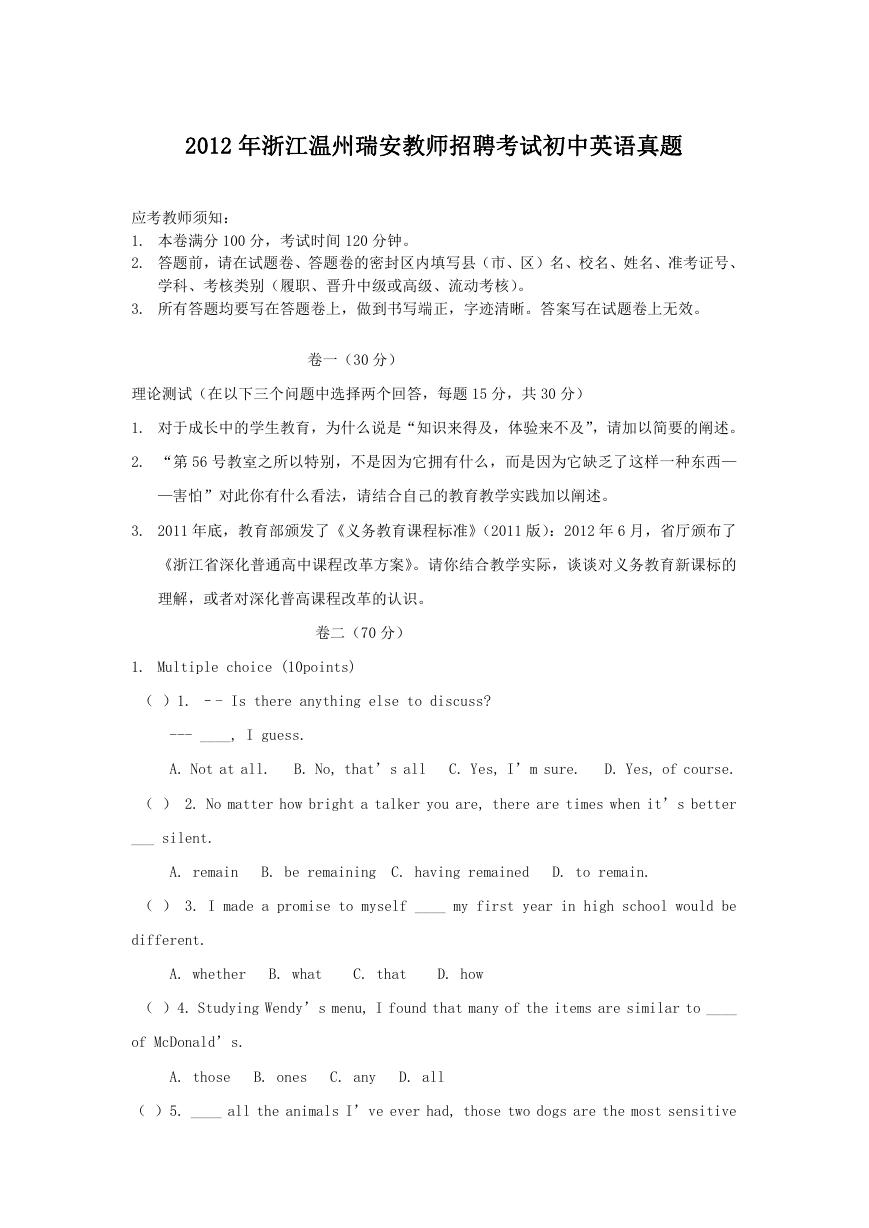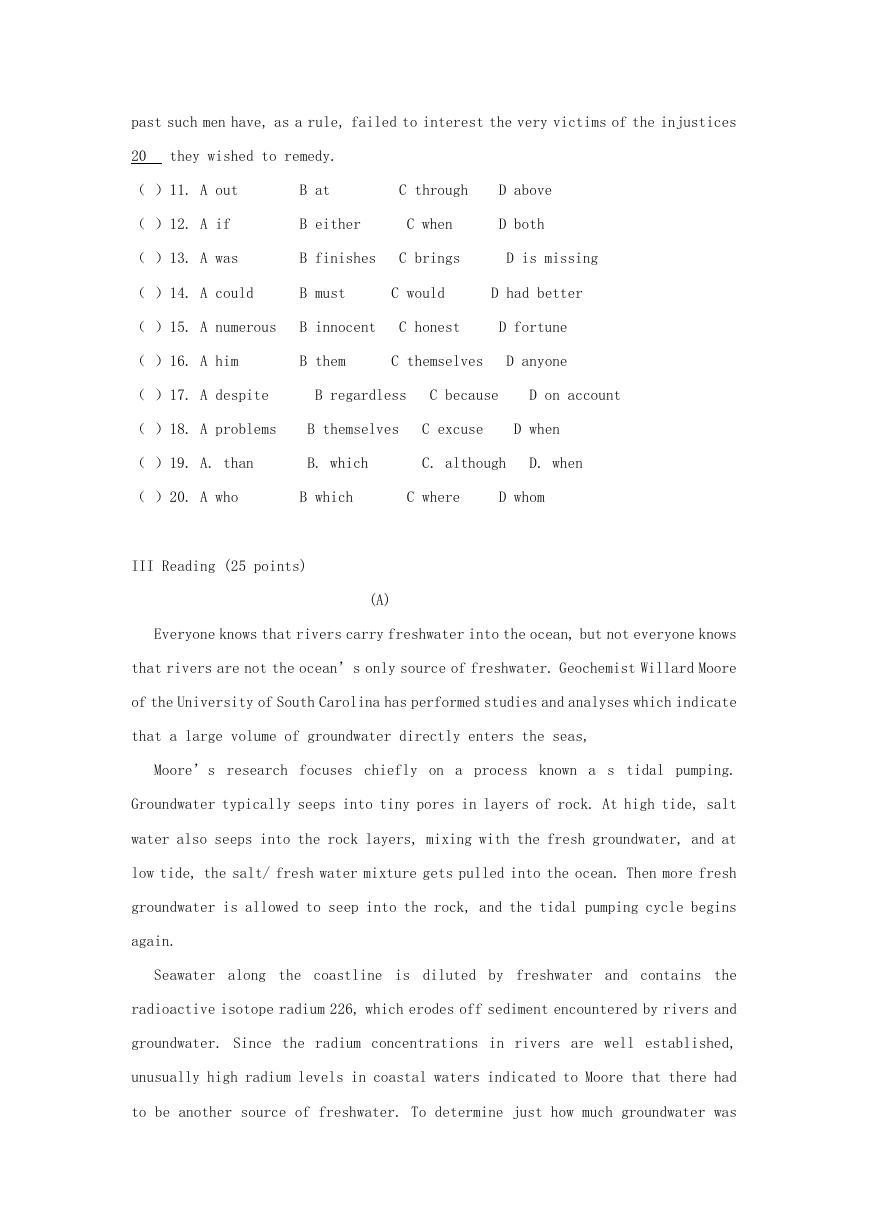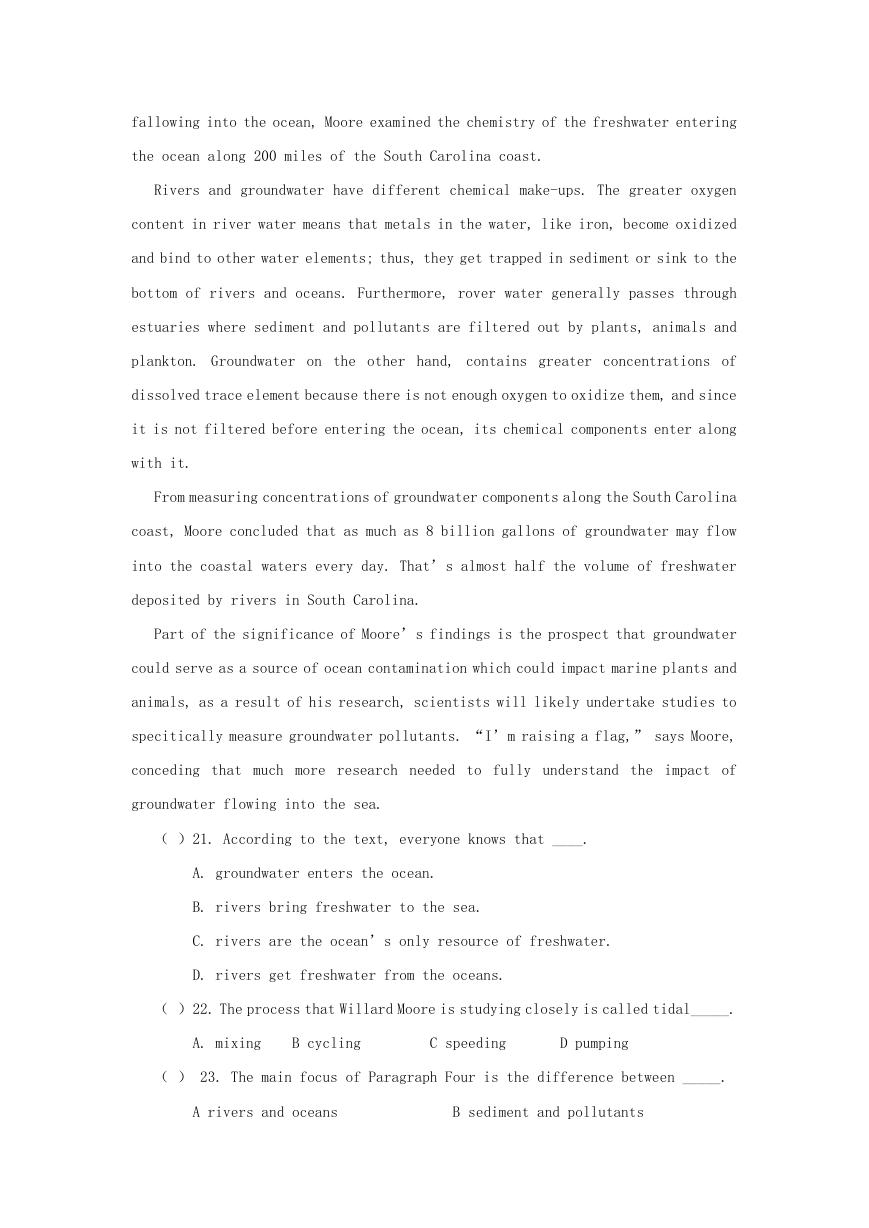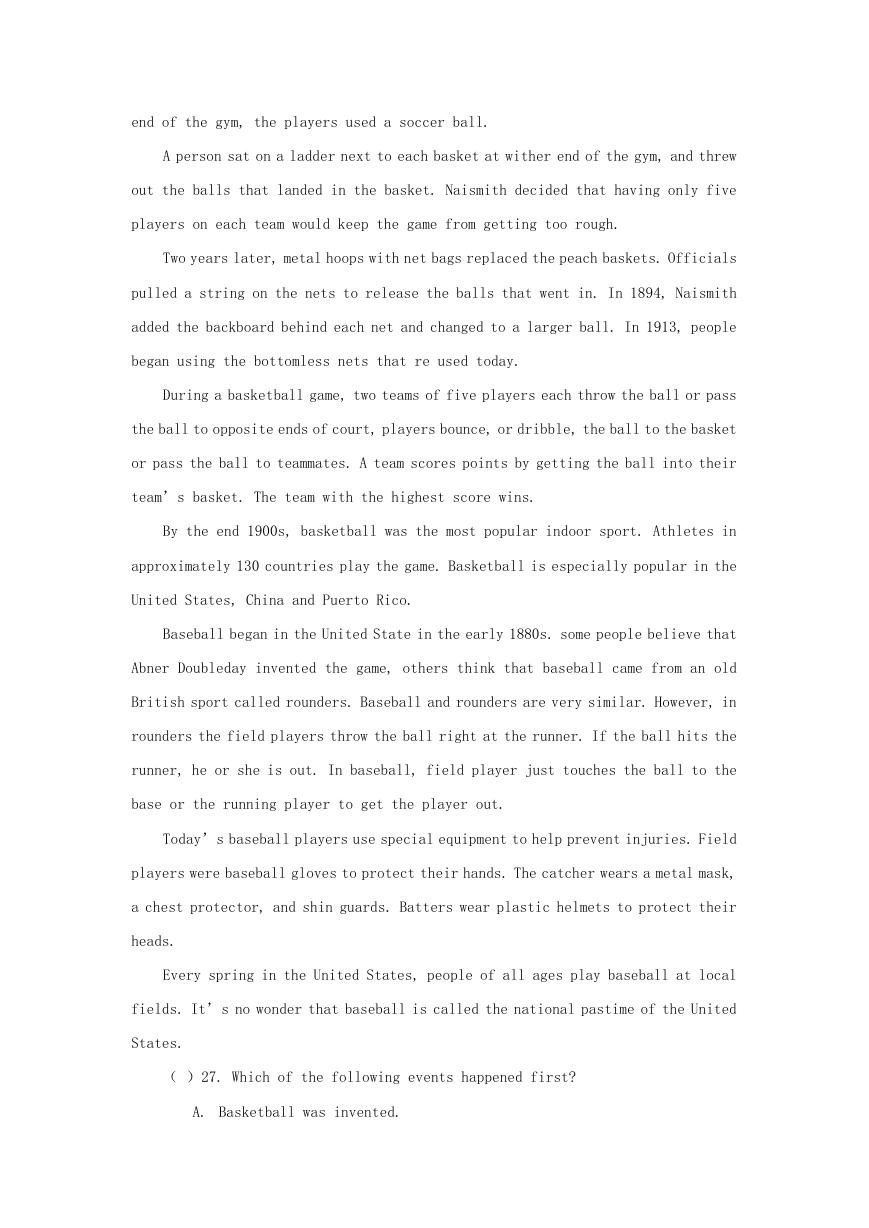2012 年浙江温州瑞安教师招聘考试初中英语真题
应考教师须知:
1. 本卷满分 100 分,考试时间 120 分钟。
2. 答题前,请在试题卷、答题卷的密封区内填写县(市、区)名、校名、姓名、准考证号、
学科、考核类别(履职、晋升中级或高级、流动考核)。
3. 所有答题均要写在答题卷上,做到书写端正,字迹清晰。答案写在试题卷上无效。
卷一(30 分)
理论测试(在以下三个问题中选择两个回答,每题 15 分,共 30 分)
1. 对于成长中的学生教育,为什么说是“知识来得及,体验来不及”,请加以简要的阐述。
2. “第 56 号教室之所以特别,不是因为它拥有什么,而是因为它缺乏了这样一种东西—
—害怕”对此你有什么看法,请结合自己的教育教学实践加以阐述。
3. 2011 年底,教育部颁发了《义务教育课程标准》(2011 版):2012 年 6 月,省厅颁布了
《浙江省深化普通高中课程改革方案》。请你结合教学实际,谈谈对义务教育新课标的
理解,或者对深化普高课程改革的认识。
卷二(70 分)
1. Multiple choice (10points)
( )1. –- Is there anything else to discuss?
--- ____, I guess.
A. Not at all.
B. No, that’s all
C. Yes, I’m sure.
D. Yes, of course.
( ) 2. No matter how bright a talker you are, there are times when it’s better
___ silent.
A. remain
B. be remaining
C. having remained
D. to remain.
( ) 3. I made a promise to myself ____ my first year in high school would be
different.
A. whether
B. what
C. that
D. how
( )4. Studying Wendy’s menu, I found that many of the items are similar to ____
of McDonald’s.
A. those
B. ones
C. any
D. all
( )5. ____ all the animals I’ve ever had, those two dogs are the most sensitive
�
to the local dialect that I speak.
A. From
B. Of
C. For
D. With
( )6. The research lacks ____ evidence, and therefore, it’s conclusions are
doubtful.
A. solid
B. fierce
C. severe
D. potential
( ) 7. Brown said he was by no means annoyed, ____ , he was glad to be able make
himself clearly understood.
A. All in all
B. For one thing
C. On the contrary
D. By the way
( )8. – Alvin, are you coming with us?
-- I’d love to, but something unexpected ______.
A. has come up
B. was coming up
C. had come up
D would come up
( )9. Mike was usually so careful, ____ this time he made a small mistake.
A. thus
B still
C even
D yet
( )10. Had they known what was coming next, they ____ second thoughts.
A. may have
B could have
C must have had
D might have had
II Cloze (10 points)
Most men and women pass 11
life without ever considering or criticizing 12
their own conditions or those of the world at large. They find themselves born into
a certain place in society, and they accept what each day 13
, without any thought
beyond what the immediate present requires. They seek the satisfaction of the needs
of moment, without much forethought, and without thinking that by sufficient effort
the conditions of their lives 14
be changed. A certain percentage , guided by
personal ambition, make the effort of thought and will which is necessary to place
themselves among the more 15 members of the community; but very few among these
seriously concerned to secure for all the advantage which they seek for 16
. Only
a few rare and exceptional men have that kind of love toward mankind at large that
makes them unable to endure patiently the general mass of evil and suffering,
17
of any relation it may have to their own lives. These few, driven by sympathetic
pain, will seek for some new system of society by which life may become richer, more
full of
18
and less full preventable evils 19
it is at present. But in the
�
past such men have, as a rule, failed to interest the very victims of the injustices
20
they wished to remedy.
( )11. A out
B at
C through
D above
( )12. A if
B either
C when
D both
( )13. A was
B finishes
C brings
D is missing
( )14. A could
B must
C would
D had better
( )15. A numerous
B innocent
C honest
D fortune
( )16. A him
B them
C themselves
D anyone
( )17. A despite
B regardless
C because
D on account
( )18. A problems
B themselves
C excuse
D when
( )19. A. than
B. which
C. although
D. when
( )20. A who
B which
C where
D whom
III Reading (25 points)
(A)
Everyone knows that rivers carry freshwater into the ocean, but not everyone knows
that rivers are not the ocean’s only source of freshwater. Geochemist Willard Moore
of the University of South Carolina has performed studies and analyses which indicate
that a large volume of groundwater directly enters the seas,
Moore’s research focuses chiefly on a process known a s tidal pumping.
Groundwater typically seeps into tiny pores in layers of rock. At high tide, salt
water also seeps into the rock layers, mixing with the fresh groundwater, and at
low tide, the salt/ fresh water mixture gets pulled into the ocean. Then more fresh
groundwater is allowed to seep into the rock, and the tidal pumping cycle begins
again.
Seawater along the coastline is diluted by freshwater and contains the
radioactive isotope radium 226, which erodes off sediment encountered by rivers and
groundwater. Since the radium concentrations in rivers are well established,
unusually high radium levels in coastal waters indicated to Moore that there had
to be another source of freshwater. To determine just how much groundwater was
�
fallowing into the ocean, Moore examined the chemistry of the freshwater entering
the ocean along 200 miles of the South Carolina coast.
Rivers and groundwater have different chemical make-ups. The greater oxygen
content in river water means that metals in the water, like iron, become oxidized
and bind to other water elements; thus, they get trapped in sediment or sink to the
bottom of rivers and oceans. Furthermore, rover water generally passes through
estuaries where sediment and pollutants are filtered out by plants, animals and
plankton. Groundwater on the other hand, contains greater concentrations of
dissolved trace element because there is not enough oxygen to oxidize them, and since
it is not filtered before entering the ocean, its chemical components enter along
with it.
From measuring concentrations of groundwater components along the South Carolina
coast, Moore concluded that as much as 8 billion gallons of groundwater may flow
into the coastal waters every day. That’s almost half the volume of freshwater
deposited by rivers in South Carolina.
Part of the significance of Moore’s findings is the prospect that groundwater
could serve as a source of ocean contamination which could impact marine plants and
animals, as a result of his research, scientists will likely undertake studies to
specitically measure groundwater pollutants. “I’m raising a flag,” says Moore,
conceding that much more research needed to fully understand the impact of
groundwater flowing into the sea.
( )21. According to the text, everyone knows that ____.
A. groundwater enters the ocean.
B. rivers bring freshwater to the sea.
C. rivers are the ocean’s only resource of freshwater.
D. rivers get freshwater from the oceans.
( )22. The process that Willard Moore is studying closely is called tidal_____.
A. mixing
B cycling
C speeding
D pumping
( ) 23. The main focus of Paragraph Four is the difference between _____.
A rivers and oceans
B sediment and pollutants
�
C irons and trace elements
D river water and groundwater
( )24. We can conclude from this paragraph that about _____ billion gallons
of freshwater enter South Carolina coastal waters every day.
A four
B eight
C twelve
D sixteen
(B)
For centuries, people have been playing kicking games with a ball. The game of
soccer developed from some of these early games, the English probably gave soccer
it’s name and its first set of rules. In European countries, soccer is called
football or association football. Some people believe that the name of “ soccer”
came from “assoc”, an abbreviation for the word association. Others believe that
the name came from the high socks that the players were.
Organized soccer games began in 1863. In soccer, two teams of eleven players try
to kick pr head the ball into their opponents’ goal. The goalie, who tried to keep
the ball out of the goal, is the only player on the field who is allowed to touch
the ball with his or her hands. The other players must use their feet , heads, and
bodies to control the ball.
Every four years, soccer teams around the world compete for the World Cup. The
World Cup competition started in 1930.
Brazil is the home of many great soccer players, including the most famous player
of all, Pele. With his fast footwork, dazzling speed, and great scoring ability,
Pele played for many years in Brazil and later in New York. During his 22 years in
soccer, he scored 1,281 goals and held every major record for the sport.
People in more than 140 countries around the world play soccer. It is the national
sport of most European and Latin American countries. Soccer is definitely the
world’s most popular sport!
James Naismith, a physical education teacher in Massachusetts, invented
basketball in 1891. Naismith’s boss asked him to invent a game that students could
play indoors during bad weather. He wanted to find a game that wasn’t as physically
rough as soccer, football, or wrestling.
Naismith attached peach basket to a railing ten feet above the floor at either
�
end of the gym, the players used a soccer ball.
A person sat on a ladder next to each basket at wither end of the gym, and threw
out the balls that landed in the basket. Naismith decided that having only five
players on each team would keep the game from getting too rough.
Two years later, metal hoops with net bags replaced the peach baskets. Officials
pulled a string on the nets to release the balls that went in. In 1894, Naismith
added the backboard behind each net and changed to a larger ball. In 1913, people
began using the bottomless nets that re used today.
During a basketball game, two teams of five players each throw the ball or pass
the ball to opposite ends of court, players bounce, or dribble, the ball to the basket
or pass the ball to teammates. A team scores points by getting the ball into their
team’s basket. The team with the highest score wins.
By the end 1900s, basketball was the most popular indoor sport. Athletes in
approximately 130 countries play the game. Basketball is especially popular in the
United States, China and Puerto Rico.
Baseball began in the United State in the early 1880s. some people believe that
Abner Doubleday invented the game, others think that baseball came from an old
British sport called rounders. Baseball and rounders are very similar. However, in
rounders the field players throw the ball right at the runner. If the ball hits the
runner, he or she is out. In baseball, field player just touches the ball to the
base or the running player to get the player out.
Today’s baseball players use special equipment to help prevent injuries. Field
players were baseball gloves to protect their hands. The catcher wears a metal mask,
a chest protector, and shin guards. Batters wear plastic helmets to protect their
heads.
Every spring in the United States, people of all ages play baseball at local
fields. It’s no wonder that baseball is called the national pastime of the United
States.
( )27. Which of the following events happened first?
A. Basketball was invented.
�
B. World Cup competition was invented.
C. Baseball began in the U.S.
D. Organized soccer games began.
( )28. Pele is a famous ____.
A. soccer player
B baseball coach
C basketball player
D baseball player
( )29. What conclusion can you draw from this article?
A. Sports are more popular in Brazil than in the U. S.
B. Most sports involve kicking a ball.
C. Sports can be very dangerous.
D. Sports are popular in many different countries.
( ) 30. Read this sentence from the story: With his fast footwork, dazzling
speed, and great scoring ability, Pele played for many years in Brazil, and then
later in New York. What does dazzling mean?
A light
B funny
C amazing
D difficult
31. Write a brief summary of the article, using only the most important details.
(5 points )
_____________________________________________________________________
_____________________________________________________________________
IV
Understanding of TEFL. (25 points )
TBLT (Task-based Language Teaching) is claimed to be helpful in EFL/ SEL
teaching. However, many teachers and researchers argue that it is not a s effective
as it is estimated.
You are asked to write an essay of approximately 200-250 English words or 600-800
Chinese characters on this issue, or to write an article to show your understanding
of TBLT and your teaching expericece.
�














 2023年江西萍乡中考道德与法治真题及答案.doc
2023年江西萍乡中考道德与法治真题及答案.doc 2012年重庆南川中考生物真题及答案.doc
2012年重庆南川中考生物真题及答案.doc 2013年江西师范大学地理学综合及文艺理论基础考研真题.doc
2013年江西师范大学地理学综合及文艺理论基础考研真题.doc 2020年四川甘孜小升初语文真题及答案I卷.doc
2020年四川甘孜小升初语文真题及答案I卷.doc 2020年注册岩土工程师专业基础考试真题及答案.doc
2020年注册岩土工程师专业基础考试真题及答案.doc 2023-2024学年福建省厦门市九年级上学期数学月考试题及答案.doc
2023-2024学年福建省厦门市九年级上学期数学月考试题及答案.doc 2021-2022学年辽宁省沈阳市大东区九年级上学期语文期末试题及答案.doc
2021-2022学年辽宁省沈阳市大东区九年级上学期语文期末试题及答案.doc 2022-2023学年北京东城区初三第一学期物理期末试卷及答案.doc
2022-2023学年北京东城区初三第一学期物理期末试卷及答案.doc 2018上半年江西教师资格初中地理学科知识与教学能力真题及答案.doc
2018上半年江西教师资格初中地理学科知识与教学能力真题及答案.doc 2012年河北国家公务员申论考试真题及答案-省级.doc
2012年河北国家公务员申论考试真题及答案-省级.doc 2020-2021学年江苏省扬州市江都区邵樊片九年级上学期数学第一次质量检测试题及答案.doc
2020-2021学年江苏省扬州市江都区邵樊片九年级上学期数学第一次质量检测试题及答案.doc 2022下半年黑龙江教师资格证中学综合素质真题及答案.doc
2022下半年黑龙江教师资格证中学综合素质真题及答案.doc